
Edward Winter
From the privately distributed 1994 edition of Chess Personalia by Jeremy Gaige:

***

The Times, 1 July 1896, page 12
Seldom nowadays does a chess treatise use the term ‘Wyvill formation’ (or, indeed, the term ‘treatise’).
From page 153 of The Unknown Capablanca by D. Hooper and D. Brandreth (London, 1975), concerning the game Capablanca v Haussmann, Philadelphia, 1918:
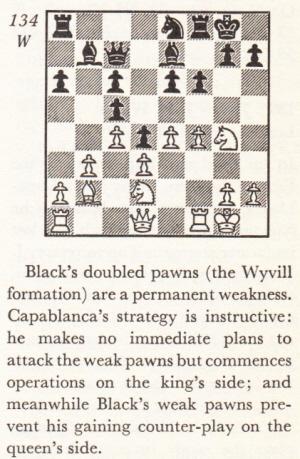
The ‘Wyvill formation’ was the description used in The Middle Game by M. Euwe and H. Kramer (London, 1964). Below, for example, is an extract from page 146 of book one:
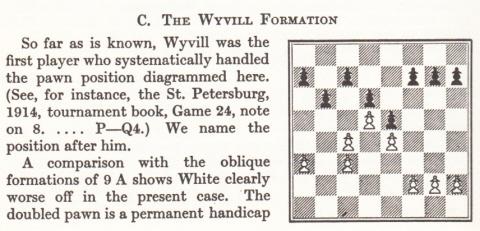
The Euwe/Kramer work was originally published in Dutch in the 1950s, in five parts, and we are grateful to Harrie Grondijs (Rijswijk, the Netherlands) for providing the text about ‘De Wyvill-formatie’ on page 49 of Het middenspel, part three (The Hague and Djakarta, 1953):
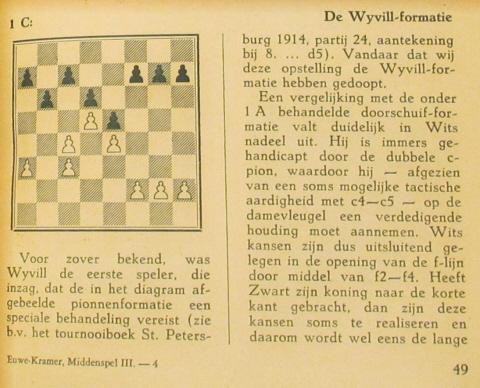
The Tarrasch passage referred to by Euwe and Kramer was on page 59 of Das Grossmeisterturnier zu St Petersburg im Jahre 1914 (Nuremberg, 1914):
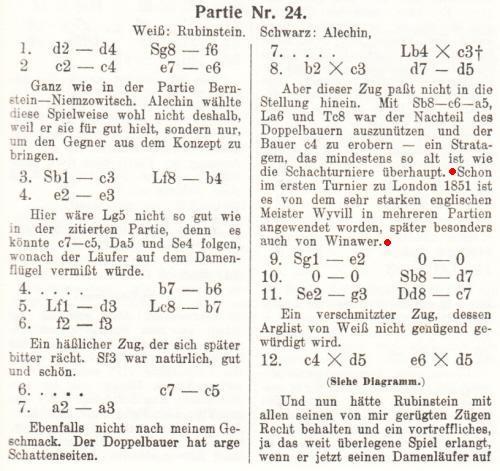
Did Tarrasch refer to Wyvill elsewhere in his writings, perhaps even using the specific phrase ‘Wyvill formation’?
On page 27 of Die Kunst der Bauernführung (Berlin-Frohnau, 1956) Hans Kmoch discussed ‘Die Wyvill-Formation’ and on page 257 added the ‘Wyvill-Benoni’ and ‘Wyvill-Rudi’. On page 277 of the English edition, Pawn Power in Chess (New York, 1959), readers were treated to the ‘Rex-Wyvill’ and the ‘Benoni-Wyvill’:
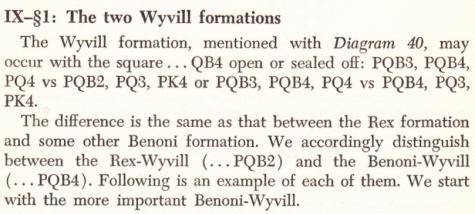
(8256)
From Joose Norri (Helsinki):
‘In an article in the 7-8/2003 issue of Suomen Shakki I pointed out, on pages 234 and 244, that there is some confusion about the Wyvill formation. Firstly, Tarrasch attributes to Wyvill the stratagem ...Na5, ...Ba6 and ...Rc8, whereas Euwe/Kramer and Kmoch use his name to describe the actual pawn structure. More importantly, I believe that Tarrasch was mistaken. No such game by Wyvill from London, 1851 exists. In one game, Wyvill v Anderssen, he had the doubled pawns, but he is supposed to have recognized the weakness of such pawns and not to have had them.
There are, however, two games played by Elijah Williams at London, 1851 (Staunton v Williams and particularly Löwenthal v Williams) which fit the description. Williams never had time to carry out the whole manoeuvre with the knight, bishop and rook, but he clearly intended it.
There remains the question of whether Wyvill used the idea somewhere else.’
(8268)
The remainder of the above annotation in The Unknown Capablanca makes a comparison with another simultaneous game, against L.L. Labatt, New Orleans, 1915, ...
‘... in which the unusual situation arises of a Wyvill formation on the king’s side. Capablanca’s strategy is just the same: he operates on both sides of the board, draws away the defender’s pieces, and, at a suitable moment, he strikes at the doubled pawns.’
That game is discussed in C.N. 6943. See also José Raúl Capablanca Miscellanea.
An item about Marmaduke Wyvill in Cuttings:
From Raymond Keene’s chess column in The Spectator, 13 May 1989, page 51:
‘In 1847 he was elected MP for Richmond, Yorkshire, a seat he held until 1868, barring a break of two years. ... He played in no further tournaments, although it is said that he retained an interest in chess throughout his life.’
From page 381 of the Oxford Companion to Chess by D. Hooper and K. Whyld (Oxford, 1984):
‘In 1847 he was elected Member of Parliament for Richmond, Yorkshire, a seat he held until 1868 except for a break of two years ... Although he played in no more tournaments he retained an interest in the game throughout his life.’
From a contribution by Gene Gnandt (Houston, TX, USA) in C.N. 5958:
‘The earliest reference to photographs of masters that I was able to find comes with regard to a well-known sketch which appeared on page 44 of the Illustrated London News, 14 July 1855. Over 40 years later, Rosario Aspa wrote a letter to the BCM (August 1896, pages 331-332) about Marmaduke Wyvill. He remarked in part:
“In those days I had already become an ardent amateur photographer and, needless to say, I did not let this opportunity go by of securing portraits of so many great chessplayers. A week or two after the meeting, the Illustrated London News gave in woodcuts from my negatives the six players of the match just described, Lord Lyttelton, the president of the meeting, sitting in their midst. I have been told that the portrait of Staunton is the only one known, and in the group Mr Marmaduke Wyvill will be found sitting at his right hand.”’
See below for further information about the illustration.
Gerard Killoran (Ilkley, England) provides this game from Löwenthal’s column in the Era, 18 December 1864, page 4:
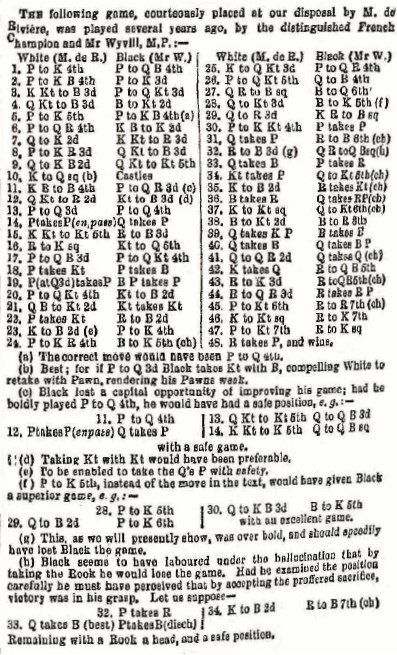
1 e4 c5 2 f4 e6 3 Nf3 b6 4 Nc3 Bb7 5 e5 f5 6 a4 Be7 7 Qe2 Nh6 8 h3 Nc6 9 Qf2 Nb4 10 Kd1 O-O 11 Bc4 a6 12 Na2 Nc6 13 d3 d5 14 exd6 Qxd6 15 Ng5 Rf6 16 Re1 Nd4 17 c3
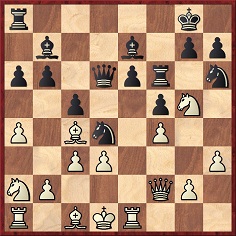
17...b5 18 cxd4 bxc4 19 dxc4 cxd4 20 b4 Nf7 21 Bb2 Nxg5 22 fxg5 Rf7 23 Kc2 e5 24 h4 Be4+ 25 Kb3 a5 26 b5 Qc5 27 Rac1 Bd3 28 Qg3 Be4 29 Qh3 Rff8 30 g4 fxg4 31 Qxg4 Rf3+
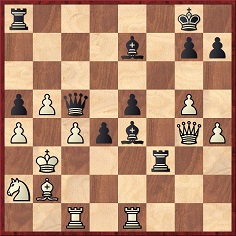
32 Rc3 Rc8 33 Qxe4 dxc3 34 Nxc3 Qb4+ 35 Kc2 Rxc3+ 36 Bxc3 Qxa4+ 37 Kb1 Qb3+ 38 Bb2 Ba3 39 Qxe5 Bxb2 40 Qxb2 Qxc4 41 Qa2 Qxa2+ 42 Kxa2 Rc4 43 Re3 Ra4+ 44 Ra3 Rxh4 45 b6 Rh2+ 46 Kb1 Re2 47 b7 Re8 48 Rxa5 ‘and wins’.
The occasion was not specified, but Mr Killoran suggests, based on the lengthy material on page 2 of the Royal Leamington Spa Courier and Warwickshire Standard, 30 June 1855, that the game was played in Leamington in 1855. See too pages 255-267 of the Chess Player’s Chronicle, 1855.
Both de Rivière and Wyvill are in the Leamington, 1855 illustration discussed in Pictures of Howard Staunton.
(10049)
This tinted version of the Leamington, 1855 image was shown by its owner, Michael Clapham (Ipswich, England), in C.N. 5976:
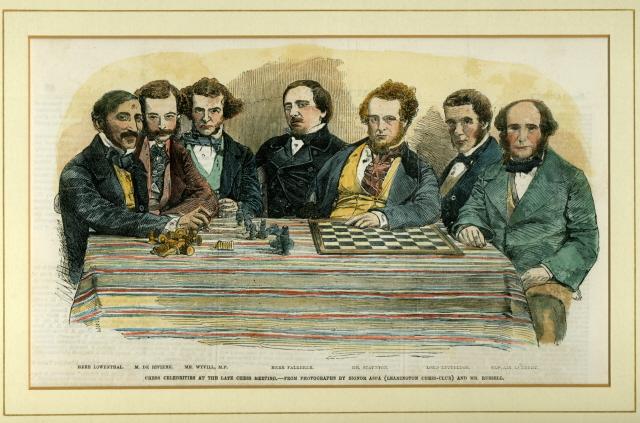

Marmaduke Wyvill
A small picture of Wyvill was given on the square h1 of the photographic chessboard shown in C.N. 3467.
A brief extract from a contribution on Elijah Williams by John Townsend (Wokingham, England) in C.N. 11424:
‘His highest achievement was in the 1851 London tournament. After knocking out Löwenthal and Mucklow, he played a semi-final match against Marmaduke Wyvill. He took the first three games to stand on the verge of a place in the final, needing just one more win, but Wyvill, the MP for Richmond, Yorkshire, staged an extraordinary come-back and took the next four games. Williams’ peak had arrived and passed. Nevertheless, by his victory in the contest to decide third place he showed that he was capable of winning a match even against Staunton.’
An addition from John Townsend:
‘The National Probate Calendar indicates that Marmaduke Wyvill died on 25 June 1896 at Ravenshall, West Cliffe, Bournemouth; probate was granted on 17 October 1896 to his son, Marmaduke D’Arcy Wyvill, esquire, the effects amounting to £1,732 2s 2d.’
See also Chess and the House of Commons.
To the Archives
for other feature articles.
Copyright Edward Winter. All rights reserved.